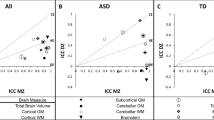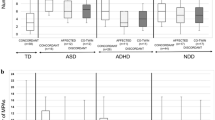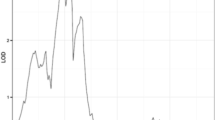Abstract
To determine the genetic relationship between head circumference (HC) and Autism Spectrum Disorders (ASDs). Twin pairs with at least one twin with an ASD were assessed. HCs in affected and unaffected individuals were compared, as were HC correlations in monozygotic and dizygotic pairs. 404 subjects, ages 4–18, were included. 20 % of males and 27 % of females with an ASD had macrocephaly. Unaffected co-twins showed similar rates (16 % of males and 22 % of females). Statistical analysis revealed no significant difference in HCs between affected and unaffected twins. Twins with ASDs and unaffected co-twins have similar HCs and increased rates of macrocephaly. Correlations demonstrated partial inheritance of HCs. Thus, macrocephaly may represent an endophenotype in ASDs.

Similar content being viewed by others
References
Abrahams, B. S., & Geschwind, D. H. (2008). Advances in autism genetics: On the threshold of a new neurobiology. Nature Reviews Genetics, 9(6), 341–355.
Anney, R., Klei, L., Pinto, D., Regan, R., Conroy, J., Magalhaes, T. R., et al. (2010). A genome-wide scan for common alleles affecting risk for autism. Human Molecular Genetics, 19(20), 4072–4082.
Arbuckle, T. E., Wilkins, R., & Sherman, G. J. (1993). Birth weight percentiles by gestational age in Canada. Obstetrics and Gynecology, 81(1), 39–48.
Bailey, A., Le Couteur, A., Gottesman, I., Bolton, P., Simonoff, E., Yuzda, E., et al. (1995). Autism as a strongly genetic disorder: Evidence from a British twin study. [Research Support, Non-U.S. Gov’t Twin Study]. Psychological Medicine, 25(1), 63–77.
Barnard-Brak, L., Sulak, T., & Hatz, J. K. (2011). Macrocephaly in children with autism spectrum disorders. [Comparative Study]. Pediatric Neurology, 44(2), 97–100. doi:10.1016/j.pediatrneurol.2010.09.011.
Bolton, P. F., Roobol, M., Allsopp, L., & Pickles, A. (2001). Association between idiopathic infantile macrocephaly and autism spectrum disorders. [Letter]. Lancet, 358(9283), 726–727. doi:10.1016/S0140-6736(01)05903-7.
Buxbaum, J. D., Cai, G., Nygren, G., Chaste, P., Delorme, R., Goldsmith, J., et al. (2007). Mutation analysis of the NSD1 gene in patients with autism spectrum disorders and macrocephaly. [Research Support, N.I.H., Extramural Research Support, Non-U.S. Gov’t]. BMC Medical Genetics, 8, 68. doi:10.1186/1471-2350-8-68.
Carper, R. A., Moses, P., Tigue, Z. D., & Courchesne, E. (2002). Cerebral lobes in autism: Early hyperplasia and abnormal age effects. NeuroImage, 16(4), 1038–1051. doi:10.1006/nimg.2002.1099.
Constantino, J. (2002). The social responsiveness scale. Los Angeles, CA: Western Psychological Services.
Constantino, J. N., Davis, S., Todd, R., Schindler, M., Gross, M., Brophy, S., et al. (2003). Validation of a brief quantitative measure of autistic traits: Comparison of the social responsiveness scale with the autism diagnostic interview-revised. Journal of Autism and Developmental Disorders, 33(4), 427–433.
Constantino, J. N., Majmudar, P., Bottini, A., Arvin, M., Virkud, Y., Simons, P., et al. (2010). Infant head growth in male siblings of children with and without autism spectrum disorders. Journal of neurodevelopmental disorders, 2(1), 39–46. doi:10.1007/s11689-009-9036-5.
Courchesne, E. (2004). Brain development in autism: early overgrowth followed by premature arrest of growth. [Research Support, U.S. Gov’t, P.H.S.Review]. Mental Retardation and Developmental Disabilities Research Reviews, 10(2), 106–111. doi:10.1002/mrdd.20020.
Courchesne, E., Carper, R., & Akshoomoff, N. (2003). Evidence of brain overgrowth in the first year of life in autism. [Research Support, U.S. Gov’t, P.H.S.]. JAMA, the Journal of the American Medical Association, 290(3), 337–344. doi:10.1001/jama.290.3.337.
Davidovitch, M., Patterson, B., & Gartside, P. (1996). Head circumference measurements in children with autism. [Research Support, U.S. Gov’t, P.H.S.]. Journal of Child Neurology, 11(5), 389–393.
Deutsch, C. K., & Joseph, R. M. (2003). Brief report: Cognitive correlates of enlarged head circumference in children with autism. [Research Support, U.S. Gov’t, P.H.S.]. Journal of Autism and Developmental Disorders, 33(2), 209–215.
Dunn, D., Dunn, L., & Dunn, L. (2006). Peabody picture vocabulary test (4th ed.). Bloomington, MN: Pearson Education, Inc.
Falconer, D., & MacKay, T. (1996). Heritability. In Introduction to quantitative genetics (4th ed., pp. 160–183). Harlow, Essex, UK: Longman’s Green.
Fidler, D. J., Bailey, J. N., & Smalley, S. L. (2000). Macrocephaly in autism and other pervasive developmental disorders. [Comparative Study]. Developmental Medicine and Child Neurology, 42(11), 737–740.
Folstein, S., & Rutter, M. (1977). Infantile autism: a genetic study of 21 twin pairs. [Case Reports]. Journal of Child Psychology and Psychiatry and Allied Disciplines, 18(4), 297–321.
Freeman, B. J., Del’Homme, M., Guthrie, D., & Zhang, F. (1999). Vineland adaptive behavior scale scores as a function of age and initial IQ in 210 autistic children. Journal of Autism and Developmental Disorders, 29(5), 379–384.
Geraedts, E. J., van Dommelen, P., Caliebe, J., Visser, R., Ranke, M. B., van Buuren, S., et al. (2011). Association between head circumference and body size. Hormone Research in Paediatrics, 75(3), 213–219.
Giannandrea, M., Bianchi, V., Mignogna, M. L., Sirri, A., Carrabino, S., D’Elia, E., et al. (2010). Mutations in the small GTPase gene RAB39B are responsible for X-linked mental retardation associated with autism, epilepsy, and macrocephaly. [Research Support, N.I.H., Extramural Research Support, Non-U.S. Gov’t]. American Journal of Human Genetics, 86(2), 185–195. doi:10.1016/j.ajhg.2010.01.011.
Gottesman, I. I., & Gould, T. D. (2003). The endophenotype concept in psychiatry: Etymology and strategic intentions. The American journal of psychiatry, 160(4), 636–645.
Gundy, J. H. (2001). The pediatric physical examination. In R. A. Hoekelman (Ed.), Primary pediatric care (4th ed., p 77). St. Louis: Mosby.
Hallmayer, J., Cleveland, S., Torres, A., Phillips, J., Cohen, B., Torigoe, T., et al. (2011). Genetic heritability and shared environmental factors among twin pairs with autism. Archives of General Psychiatry,. doi:10.1001/archgenpsychiatry.2011.76.
Herbert, M. R. (2005). Large brains in autism: The challenge of pervasive abnormality. [Research Support, Non-U.S. Gov’t Review]. The Neuroscientist: A Review Journal Bringing Neurobiology, Neurology and Psychiatry, 11(5), 417–440. doi:10.1177/0091270005278866.
Ivanovic, D. M., Leiva, B. P., Perez, H. T., Olivares, M. G., Diaz, N. S., Urrutia, M. S., et al. (2004). Head size and intelligence, learning, nutritional status and brain development. Head, IQ, learning, nutrition and brain [Research Support, Non-U.S. Gov’t]. Neuropsychologia, 42(8), 1118–1131. doi:10.1016/j.neuropsychologia.2003.11.022.
Kanner, L. (1943). Autistic disturbances of affective contact. Nervous Child, 2(21), 217–250.
Kraijer, D. (2000). Review of adaptive behavior studies in mentally retarded persons with autism/pervasive developmental disorder. [Review]. Journal of Autism and Developmental Disorders, 30(1), 39–47.
Kuczmarski, R. J., Ogden, C. L., Grummer-Strawn, L. M., Flegal, K. M., Guo, S. S., Wei, R., et al. (2000). CDC growth charts: United States. Advance Data, (314), 1–27.
Lainhart, J. E., Bigler, E. D., Bocian, M., Coon, H., Dinh, E., Dawson, G., et al. (2006). Head circumference and height in autism: A study by the collaborative program of excellence in autism. [Multicenter study research support, N.I.H., extramural]. American Journal of Medical Genetics. Part A, 140(21), 2257–2274. doi:10.1002/ajmg.a.31465.
Lord, C., Risi, S., Lambrecht, L., Cook, E. H, Jr, Leventhal, B. L., DiLavore, P. C., et al. (2000). The autism diagnostic observation schedule-generic: A standard measure of social and communication deficits associated with the spectrum of autism. Journal of Autism and Developmental Disorders, 30(3), 205–223.
Lord, C., Rutter, M., DiLavore, P. C., & Risi, S. (1999). Autism diagnostic observation schedule—WPS (WPS edn.). Los Angeles.
Lord, C., Rutter, M., & Le Couteur, A. (1994). Autism diagnostic interview-revised: A revised version of a diagnostic interview for caregivers of individuals with possible pervasive developmental disorders. [Research support, non-U.S. Gov’t research support, U.S. Gov’t, P.H.S.]. Journal of Autism and Developmental Disorders, 24(5), 659–685.
Menounou, A. (2011). Head size: Is it important? Advances in Clinical Neuroscience and Rehabilitation, 11(2), 16–20.
Miles, J. H., Hadden, L. L., Takahashi, T. N., & Hillman, R. E. (2000). Head circumference is an independent clinical finding associated with autism. [Research support, non-U.S. Gov’t]. American Journal of Medical Genetics, 95(4), 339–350.
Moreno-De-Luca, D., Mulle, J. G., Kaminsky, E. B., Sanders, S. J., Myers, S. M., Adam, M. P., et al. (2010). Deletion 17q12 is a recurrent copy number variant that confers high risk of autism and schizophrenia. [Research support, N.I.H., extramural research support, non-U.S. Gov’t]. American Journal of Human Genetics, 87(5), 618–630. doi:10.1016/j.ajhg.2010.10.004.
Mraz, K. D., Green, J., Dumont-Mathieu, T., Makin, S., & Fein, D. (2007). Correlates of head circumference growth in infants later diagnosed with autism spectrum disorders. [Research support, N.I.H., extramural]. Journal of Child Neurology, 22(6), 700–713. doi:10.1177/0883073807304005.
Mullen, E. (1995). Mullen scales of early learning manual. Circle Pines, MN: American Guidance Service Inc.
Reiss, A. L., Abrams, M. T., Singer, H. S., Ross, J. L., & Denckla, M. B. (1996). Brain development, gender and IQ in children. A volumetric imaging study. [Research Support, U.S. Gov’t, P.H.S.]. Brain: A Journal of Neurology 119(Pt 5), 1763–1774.
Risi, S., Lord, C., Gotham, K., Corsello, C., Chrysler, C., Szatmari, P., et al. (2006). Combining information from multiple sources in the diagnosis of autism spectrum disorders. [Research Support, N.I.H., Extramural]. Journal of the American Academy of Child and Adolescent Psychiatry 45(9), 1094–1103. doi:10.1097/01.chi.0000227880.42780.0e.
Roid, G. H. (2003). Stanford Binet’s intelligence scales, fifth edition, technical manual. Itasca, IL: Riverside Publishing.
Rollins, J. D., Collins, J. S., & Holden, K. R. (2010). United States head circumference growth reference charts: birth to 21 years. [Research Support, Non-U.S. Gov’t]. The Journal of pediatrics, 156(6) 907–913, 913 e901–e902. doi:10.1016/j.jpeds.2010.01.009.
Rutter, M., Le Couteur, A., & Lord, C. (2003). Autism diagnostic interview-revised. Los Angeles: Western Psychological Services.
Sacco, R., Militerni, R., Frolli, A., Bravaccio, C., Gritti, A., Elia, M., et al. (2007). Clinical, morphological, and biochemical correlates of head circumference in autism. [Research support, non-U.S. Gov’t]. Biological Psychiatry, 62(9), 1038–1047. doi:10.1016/j.biopsych.2007.04.039.
Smit, D. J., Luciano, M., Bartels, M., van Beijsterveldt, C. E., Wright, M. J., Hansell, N. K., et al. (2010). Heritability of head size in Dutch and Australian twin families at ages 0–50 years. [Research support, non-U.S. Gov’t twin study]. Twin Research and Human Genetics: The Official Journal of the International Society for Twin Studies 13(4), 370–380. doi:10.1375/twin.13.4.370.
Sparrow, S., Balla, D. A., & Cichetti, D. (2005). Vineland adaptive behavior scales (2nd ed.). Bloomington, MN.: Pearson Education, Inc.
Steffenburg, S., Gillberg, C., Hellgren, L., Andersson, L., Gillberg, I. C., Jakobsson, G., et al. (1989). A twin study of autism in Denmark, Finland, Iceland, Norway and Sweden. [Research support, non-U.S. Gov’t]. Journal of Child Psychology and Psychiatry and Allied Disciplines, 30(3), 405–416.
van Daalen, E., Swinkels, S. H., Dietz, C., van Engeland, H., & Buitelaar, J. K. (2007). Body length and head growth in the first year of life in autism. [Research support, non-U.S. Gov’t]. Pediatric Neurology, 37(5), 324–330. doi:10.1016/j.pediatrneurol.2007.06.006.
Varga, E. A., Pastore, M., Prior, T., Herman, G. E., & McBride, K. L. (2009). The prevalence of PTEN mutations in a clinical pediatric cohort with autism spectrum disorders, developmental delay, and macrocephaly. Genetics in Medicine: Official Journal of the American College of Medical Genetics, 11(2), 111–117. doi:10.1097/GIM.0b013e31818fd762.
Wickett, J. C., Vernon, P. A., & Lee, D. H. (2000). Relationships between factors of intelligence and brain volume. Personality and Individual Differences, 29(6), 1095–1122. doi:10.1016/s0191-8869(99)00258-5.
Woodhouse, W., Bailey, A., Rutter, M., Bolton, P., Baird, G., & Le Couteur, A. (1996). Head circumference in autism and other pervasive developmental disorders. [Comparative study]. Journal of Child Psychology and Psychiatry and Allied Disciplines, 37(6), 665–671.
Acknowledgments
We would like to thank the participating families for their time and dedication. Our thanks is also given to the National Institute of Mental Health (Grant R01MH067005) and Autism Speaks for funding the California Autism Twins Study.
Conflict of interest
The authors declare that they have no conflict of interest.
Author information
Authors and Affiliations
Corresponding author
Additional information
Dr. Grether is now retired.
Rights and permissions
About this article
Cite this article
Froehlich, W., Cleveland, S., Torres, A. et al. Head Circumferences in Twins With and Without Autism Spectrum Disorders. J Autism Dev Disord 43, 2026–2037 (2013). https://doi.org/10.1007/s10803-012-1751-1
Published:
Issue Date:
DOI: https://doi.org/10.1007/s10803-012-1751-1




